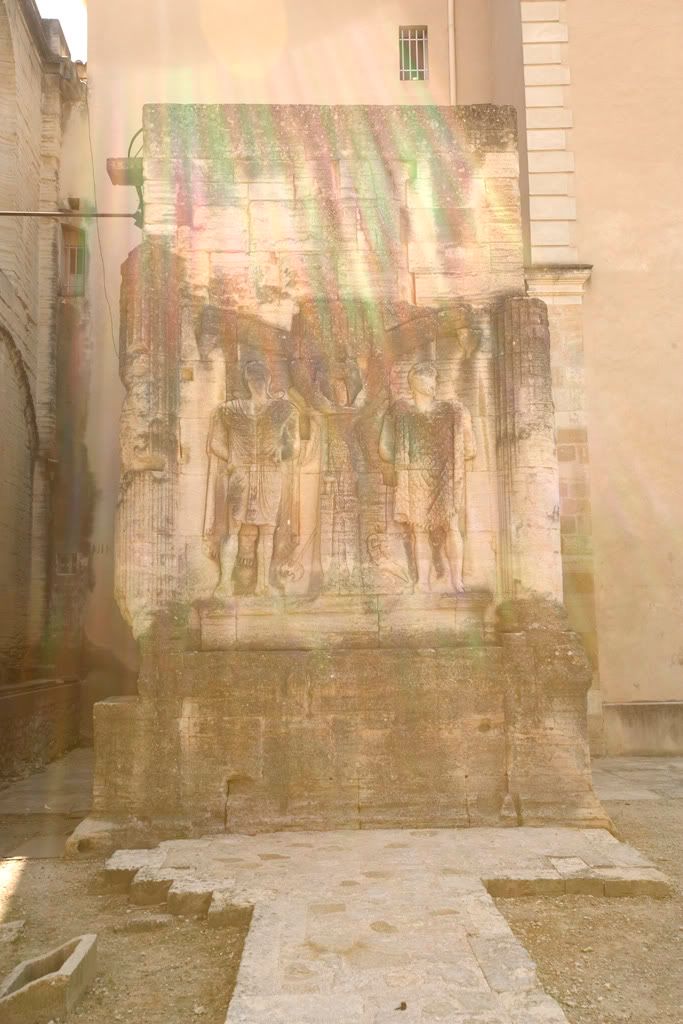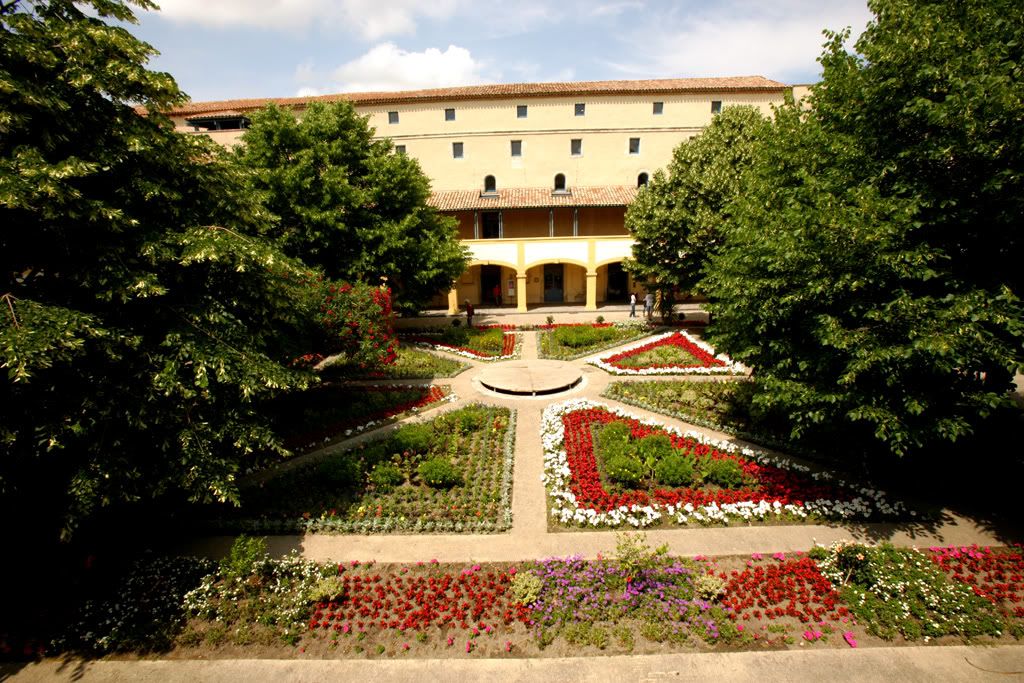Author's posts
Jun 20 2009
Three Small Towns In Provence (A Photo Blog)
Carpentras dates at least to Roman times.


Jun 15 2009
I admit it. I wish Cheney were president.
I thought it was time I outed myself. And all those like me, on left wing websites, who dare criticize President Obama. For compromising or selling out on trivial issues such as DOMA, the bank bailout, secrecy, torture, or prosecuting war crimes. We don’t really care about issues. We’re all about personality. And we all secretly wish Dick Cheney were president. Because we get the vapors for rabid weasels.
Jun 14 2009
Avignon (A Photo Blog)
By the beginning of the 14th Century, Italy was wracked by wars between rival religious and political factions, rival merchant states, and rival factions within these factions and merchant states. The “Holy” “Roman” “Emperor” Heinrich VII invaded, but failed to take Rome. And amidst this violent turmoil, Giotto reinvented art and launched the southern Renaissance, while Dante and Petrarch reinvented poetry. And also amidst this turmoil, and with his papacy threatened, Pope Clement V, under pressure from the French King Philippe IV le Bel, moved the papal court to Avignon, which was not actually in France, but was in the Venaissan enclave granted to the papacy by its Angevin clients. The next seven popes would be French, but not all Catholic nations would accept them. The Catholic Church again would be torn by schisms.
The 14th Century saw Europe torn apart and reinvented, and France was at the heart of it. The Black Death would kill perhaps eight million people, in France alone. Jews and lepers would be burned, on order of King Philip V. The Hundred Years War with England would rage. The Capetian dynasty would end. The Dukes of Burgundy, who controlled not only that modern French region, but also what are now the modern Benelux nations, sided with England, attempting to form a sort of middle kingdom, between the war-ravaged France and Germany. Under their patronage, Claus Sluter would launch the northern Renaissance.
In the 1330s, Pope Benedict XII began the massive renovation of the Avignon ecclesiastical palace, tranforming it into the grand Palais des Papes. In 1377, St. Catherine of Siena convinced Pope Gregory XI to return to Rome, which soon led to yet more schisms within the Church, including the election of an alternate pope in Avignon.
(Photo intensive, after the jump…)
Jun 12 2009
The Wisdom Of Conscious Suffering
When I had cancer, a close friend asked if I ever wondered: why me? I told her that I didn’t. I told her that given that one in three Americans will, at some point, be diagnosed with cancer, I felt why not me? Cancer happens. It’s sometimes random. It happened to me. There was neither rhyme nor reason. It just did.
A different friend recently asked the same about a close friend of mine, who was just killed in an auto accident. A speeding semi veered into his car, in a national park, in Uganda, killing him and leaving his wife widowed for the second time and seriously injured. My friend wondered: why? Why him? Why her?
Another friend asked how I took the news. If I tried to think my way through it. If I tried to look for cosmic explanations, or if I was angry at the Universe, or if I was trying to look for silver linings. I wasn’t. My friend wanted to make sure that I wasn’t trying to think my way through it, because he wanted to make sure I was allowing myself to feel my way through it. To allow the pain to wash over me, and through me. Which is the only real way to respond to emotional trauma. Did I allow myself to cry? I certainly did. And I have, off and on, for days.
Jun 08 2009
Luke Cole: An Appreciation
It is with broken heart that I report the death of one of this nation’s most important and innovative environmental attorneys.
Luke Cole graduated with honors from Stanford, and cum laude from Harvard Law School. He could have done anything. He could have gone to work for any law firm in the country, and made a fortune. Instead, he moved to San Francisco and co-founded the non-profit Center on Race, Poverty & the Environment. As described on their website:

The Center on Race, Poverty & the Environment is an environmental justice litigation organization dedicated to helping grassroots groups across the United States attack head on the disproportionate burden of pollution borne by poor people and people of color. We provide organizing, technical and legal assistance to help community groups stop immediate environmental threats. In the 16 years that CRPE has been helping the poor and people of color resist toxic intrusions and protect their environmental health, among our many victories we have beaten toxic waste incinerators, forced oil refineries to use cleaner technology, beaten a 55,000-cow mega-dairy, stopped numerous tire burning proposals, helped bring safe drinking water to various rural communities, stopped a garbage dump on the Los Coyotes reservation in southern California, and empowered hundreds of local residents along the way.
His recent work included a groundbreaking case that is succinctly explained by his law school classmate, Ann Carlson:
Cole was well-known for his work on numerous leading environmental justice cases, including as counsel for the Native Village of Kivalina in its pathbreaking case seeking damages from large greenhouse gas emitters from the melting away of their Alaskan village.
If that sounds like he was tilting at windmills, you didn’t know Luke. He wouldn’t have pursued such a case if he hadn’t believed he could win it. His successful pioneering work, taking on the California dairy industry, made him the cover boy of the February, 2002 issue of California Law Magazine, in an article titled: Got Manure? How Environmental Lawyer Luke Cole Brought Dairy Construction in the San Joaquin Valley to a Standstill.
Jun 05 2009
In The Footsteps Of Cezanne (A Photo Blog)
One’s favorite paintings are purely subjective. Since I first discovered but a poster of it, Paul Cézanne’s Le Lac d’Annecy has been among the handful of mine. The real thing resides in London’s Courtauld Gallery, but I first saw it when the Courtauld Institute was being remodeled, and the collection was shipped exclusively to Toronto. The future Mrs. T and I were headed to a friend’s wedding, in rural Ontario, and had decided to drive across the country. I’d never been to Toronto, so we planned to stay for a few days. We drove in from Indiana, had our car searched at the border, and only made it to our hotel after midnight. Except that there had been a screw-up with the reservation, so it wasn’t our hotel. And it was Gay Pride Week, which meant that almost every room in the city was booked. But the hotel manager managed to reach a friend who ran another hotel, and we ended up in a lavish business suite for the price of a small room. We got to bed around 3 a.m., woke the next day, went out exploring, and saw the banners on lampposts: The Courtauld Collection! In Toronto! Right then! It became our first stop!

(massive version here)
The haunting magic of the painting simply cannot be captured online. For one thing, Impressionism and Post-Impressionism are very much about physical texture, and unless you can see the brush strokes, you’re not really seeing the painting. And in Cézanne’s case, and specifically with this work, that often meant palette knife strokes, because Cézanne’s fascination with intersecting planes often led him to craft his art with his knife rather than with a paintbrush. And when we found the room with this painting, I could not leave. The future Mrs. T later told me she began to wonder if I would try to walk out with it.
My enchantment led a couple other visitors to inquire about it. I began explaining. A small crowd gathered. I told them to stand ten to fifteen feet back, relax their eyes, and observe the near photo-realism. The perspective is so perfect that you are transported into its depths, from the foreground tree, across the rippled reflections on the water, to the buildings and landscapes across the lake, and on up into the mountains. It’s an astonishing achievement. Because when you then walk closer, to observe the detailed knife and brush strokes and the physical texture, the image dissolves into what is almost Expressionism. Only the best Cubism similarly shimmers between near three-dimensional realism and pure abstraction. Little wonder some art historians say modern art begins with Cézanne.
May 29 2009
Famous Nefertiti Bust May Be A Fake
One of the most famous pieces of ancient art might not be so ancient, after all.
From Agence France-Presse:


May 26 2009
The Sotomayor Nomination: Reactions And Analysis
Scotusblog on the four main likely attacks:
1) That she is not smart enough for the job.
The objective evidence is that Sotomayor is in fact extremely intelligent. Graduating at the top of the class at Princeton is a signal accomplishment. Her opinions are thorough, well-reasoned, and clearly written. Nothing suggests she isn’t the match of the other Justices.
2) That she’s a liberal ideologue:
There is no question that Sonia Sotomayor would be on the left of this Supreme Court, just not the radical left. Our surveys of her opinions put her in essentially the same ideological position as Justice Souter. In the ideological cases where her rulings have been reviewed by the Supreme Court (for example, Malesko and the pending Ricci case), her views have aligned with the left of the current Court.
3) That she’s unprincipled or unfair.
The three pieces of evidence initially cited for that proposition will be (i) the disposition of the Ricci case (in which a panel on which Sotomayor sat affirmed the dismissal of white firefighters’ claims in a very short and initially unpublished opinion), (ii) a panel appearance in which she acknowledged that appellate judges effectively make policy, and (iii) a speech in which she talked about the role of her gender and ethnicity in her decision making.
These reeds are too thin for that characterization to take hold. The public neither understands nor cares about the publication practices of the courts of appeals. It also is easily able to accept a judge’s recognition of the lawmaking effects of her decisions and the influences of her background. There just isn’t any remotely persuasive evidence that Judge Sotomayor acts lawlessly or anything of the sort.
4) That she’s “gruff and impersonable”:
Judge Sotomayor’s personal remarks will resolve this question for the public, to the extent it cares at all. But there isn’t any reason to believe that she is anything other than a tough questioner. My impression from her questioning at oral arguments is that it is similar to the Chief Justice, Justice Scalia, and (in cases in which he was particularly engaged) Justice Souter.
Scotusblog believes her confirmation is assured.
Jack Balkin looks at pure pragmatics:
May 22 2009
Yes, Actually, I CAN Judge The Chemo Kid
In a bizarre post at Salon, Rahul K. Parikh, M.D. says we shouldn’t judge a family that is on the lam, so that their 13 year old son won’t have to experience the hell of chemotherapy treatments for Hodgkin’s Lymphoma:
The story of Daniel Hauser, a 13-year-old boy from Minnesota with Hodgkin’s lymphoma, became tabloid fodder overnight. The boy and his mother are on the lam because the mother refuses, because of her beliefs, to authorize chemotherapy treatments for her son. Hodgkin’s lymphoma has a 90 percent cure rate with chemotherapy, and a 95 percent chance of killing a person without it. Chemotherapy will likely save Daniel’s life, and as a pediatrician I wouldn’t hesitate for a moment to recommend it.
But I would also like to turn down the volume on the talk-radio chatter and outraged editorials. That’s because nobody seems to be talking about what it takes to beat Hodgkin’s (or any other cancer). What it takes is a grueling regimen that can indeed give even a dying person pause. In fact, the Hausers didn’t refuse chemotherapy outright. They defied doctors and a judge’s ruling only after Daniel experienced some of its violent effects following one round. If you don’t understand why, listen to my friend, Arun Ponnusamy, 36, who beat acute lymphocytic leukemia. “Surviving cancer is one thing,” he says. “Surviving chemotherapy is another thing entirely.”
I call bullshit. First of all, every type of cancer has a different chemo regimen, and because the bulk of his post is actually about Ponnusamy’s treatments, to have any credibility, Parikh must first explain the similarities between Ponnusamy’s cancer and Hauser’s. But more directly to the point, and in direct contrast to Parikh’s absurd approach, we’re talking about saving the life of a child. Hodgkin’s treatments are brutal, but they usually “cure” the cancer. As in giving the kid a chance at a full life. Which makes enduring probably 12 cycles of chemotherapy not such a terrible prospect. I would know. I am a Hodgkin’s survivor.
May 22 2009
A Blight On Humanity
Paul Krugman has a short but withering post about the fraud that was American conservatism. Riffing off a link to Crooked Timber, which has Richard Posner becoming the latest conservative to jump the movement’s ship, Krugman writes:
And yet – why, exactly, should we listen to people who by their own admission completely missed the story? I mean, anyone who actually listened to what Newt Gingrich and Dick Armey were saying in 1994, let alone what passed for thought in the Bush administration, should have realized long ago that if there ever was an intellectual basis for modern conservatism, it was long gone.
Why, indeed, would anyone pretend there is any shred of credibility in anyone who found the Gingrich and Bush eras credible? But Krugman gets to the real point in the next paragraph:
And the truth is that the Reaganauts were a pretty grotesque bunch too. Look for the golden age of conservative intellectualism in America, and you keep going back, and back, and back – and eventually you run up against William Buckley in the 1950s declaring that blacks weren’t advanced enough to vote, and that Franco was the savior of Spanish civilization.
They fought civil rights, and voting rights, and the creation of Social Security and Medicaid and Medicare. They fought the environmental movement. They fought science and education and basic human decency. They launched wars that shouldn’t have been launched, they supported terrorists and terrorist regimes all around the globe, and countless millions suffered and died for their greed, hypocrisy and plain old murderous evil. They were and are, in every way that matters, morally degenerate.
There was no golden era of the conservative movement. It held political power for many years, and if we are not vigilant, it could, yet again. Because there is literally nothing its dwindling band of deranged supporters won’t try, to regain power. But it’s time to stop acting as if it was a serious intellectual enterprise, or that its methods and ideals were even worth debating. It was sick. It was demented. It represented the very worst of humanity. It’s time to stop pretending that it was deserving of respect or legitimacy. It wasn’t. It was a blight on humanity, the human spirit, and the entire planet. It should be treated as such and remembered as such.
May 21 2009
Buhdydharma Is Bad For Daily Docudharma!
Rules, rules, rules.
So, I’m in a meta mood, and I never met a meta I didn’t abhor. Even my own.
I’m an administrator at this site, and my UID is #6, which has all sorts of implications, if you’ve ever been to Portmeiron, Wales or hung out at Daily Kos, so I have some things to say.
First of all, Israel and Palestine both suck. I haven’t decided which sucks worse, but when I do, I will be sure to post all sorts of hateful diaries about it. Because I’m pure.
Second of all, Daily Kos sucks. I could list countless reasons why it sucks. You can list countless reasons why it sucks. Buhdy doesn’t want this to be a Daily Kos bashing site, but I’m an administrator, here, and I want to bash Daily Kos! I haven’t written a thing there since earlier today, and I intend to prove my hatred for the place by not writing anything there ever again, until I feel like it. Which might be tomorrow. But it still sucks.
Third of all, you’d better be very nice to me or I’ll ban your ass! I like money. Money is good. Give me money, and I promise I won’t ban your ass. Other parts of you, maybe, but not your ass.
Fourth of all, I’m tired of counting. I’m tired. I have a toddler and a newborn, and I’m tired.
So, I guess traffic here has picked up, the past few days. Next thing you know, we’ll be inundated by pootie diaries, and then Keith Olbermann will bless us with his presence, and we can all fawn and drool. I can’t wait!
We haven’t had a good GBCW in quite a while. That’s what you n00bs are here for. We’re going to start picking on you, so some of you can get offended and leave. I can’t wait!
So, welcome everyone. Do your best to offend people and be offended, and you’ll fit right in.
May 07 2009
Van Gogh’s Ear (A Photoblog)
Vincent Van Gogh’s turbulent and tragic life makes for romantic legend, and much of it is true. But one common misconception is that he cut off his ear over the love of a woman. In fact, the official story long has been that he cut it off after a fight with his sometime friend, Paul Gauguin. The official story now has been called into question.
From Monday’s Guardian:
According to official versions, the disturbed Dutch painter cut off his ear with a razor after a row with Gauguin in 1888. Bleeding heavily, Van Gogh then walked to a brothel and presented the severed ear to an astonished prostitute called Rachel before going home to sleep in a blood-drenched bed.
But two German art historians, who have spent 10 years reviewing the police investigations, witness accounts and the artists’ letters, argue that Gauguin, a fencing ace, most likely sliced off the ear with his sword during a fight, and the two artists agreed to hush up the truth.
In Van Gogh’s Ear: Paul Gauguin and the Pact of Silence, published in Germany, Hamburg-based academics Hans Kaufmann and Rita Wildegans argue that the official version of events, based largely on Gauguin’s accounts, contain inconsistencies and that both artists hinted that the truth was more complex.
Van Gogh and Gauguin’s troubled friendship was legendary. In 1888, Van Gogh persuaded him to come to Arles in the south of France to live with him in the Yellow House he had set up as a “studio of the south”. They spent the autumn painting together before things soured. Just before Christmas, they fell out. Van Gogh, seized by an attack of a metabolic disease became aggressive and was apparently crushed when Gauguin said he was leaving for good.
Van Gogh had wrapped the ear in paper, and when he handed it to Rachel, asked her to “keep this object carefully.” Van Gogh soon was taken into custody, and placed in a hospital, where his mental state was far worse than his physical. The hospital is now a cultural center known as Espace Van Gogh.

